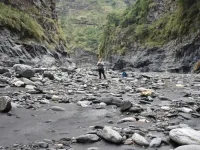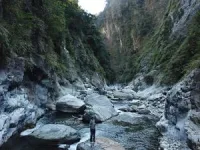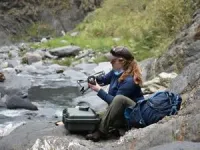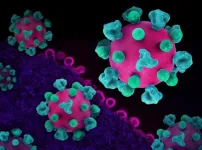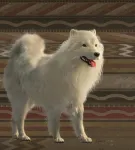(Press-News.org) UNIVERSITY PARK, Pa. — Drones flying along miles of rivers in the steep, mountainous terrain of central Taiwan and mapping the rock properties have revealed new clues about how water helps shape mountains over geological time, according to a team led by Penn State scientists.
The researchers found a link between the size of boulders in the rivers and the steepness of the rivers. The link shows how rock properties can influence the relationship between tectonic processes happening deep underground and how mountainous landscapes change shape. They reported in the journal Science Advances.
“Over the course of a mountain belt developing, we’re seeing differences in how rivers incise, or cut down into the bedrock, in the younger and older sections,” said Julia Carr, lead author of the study who earned her doctorate in geosciences from Penn State in 2022. “It means that as a mountain belt evolves, erosion is changing at the surface.”
As tectonic plates collide and form mountain ranges, rocks that were previously buried in the Earth’s crust are pushed to the surface in a process called uplift. The temperature and pressure that these rocks experience leads to variability in rock properties — like rock hardness or the spacing and orientation of fractures— that then affect how easily they are eroded by elements at the surface, the scientists said.
In Taiwan, the scientists found the main signature of rock strength of the mountains was the size of boulders in rivers, which were larger and stronger in locations where rocks had been buried deeper in Earth’s crust. And the size of boulders correlated with the steepness of the rivers, which must be powerful enough to move these boulders downstream before eroding the mountain, the scientists said.
“When the boulders in the channels are larger, the river needs to steepen to be able to erode at the same rate,” said Roman DiBiase, associate professor of geosciences at Penn State and co-author of the study. “This is because in order to erode rock, the sediment covering a river channel needs to move out of the way. The larger the boulders in the channel, the steeper the channel needs to be to move them.”
Models can account for how things like storms and floods impact erosion rates, but it’s harder to factor the role of rock strength on the process, the scientists said.
“Determining the controls on river incision into rock is important for understanding how mountain ranges evolve over geologic time,” DiBiase said. “But some key parameters for testing models of river incision, such as flow depth and sediment cover, are difficult to measure at large scales.”
The researchers turned to drones to avoid obstacles like hazardous river crossings and waterfalls to collect data. During these surveys, the scientists collected hundreds of thousands of measurements of river channel morphology and more than 22,000 measurements of boulders along roughly 18 miles of rivers.
“That’s where it’s really unprecedented — something of this scale is really unusual,” said Carr, who conducted the research at Penn State and is now a postdoctoral fellow at Simon Fraser University in British Columbia. “It’s exciting to be able to survey at this scale — it helps us see patterns we really would otherwise never see. If you just went into the field and surveyed the few spots you could get to easily, you would not observe this pattern.”
Taiwan’s central mountain range is one of the steepest landscapes on Earth and has one of the highest erosion rates of any place outside glaciated or human-influenced areas, Carr said. In addition, the tectonic setting of Taiwan is well known and has systematic burial depth patterns that can be used to evaluate the connection between subsurface history of rocks and their current condition at the surface.
“It’s this great unique place because unlike somewhere like the Himalayas or the Alps, where there’s so many complex tectonic histories, Taiwan can be a relatively simple landscape to study because the same collision forces that created it millions of years ago are still active today,” Carr said. “And these lessons learned from Taiwan can help inform erosion models that are applied to other mountain ranges with fewer constraints.”
Because of how the range formed, younger rocks are found in the south and west, while older rocks that were buried deeper — up to 24 miles underground – are found further east and north, the scientists said.
In the younger sections, rivers have fewer, smaller boulders that cover less of the area of the channels. And as you travel toward the older sections, the boulders increase to a median size of more than six feet, the scientists said.
These boulders aren’t sitting in the rivers waiting to be broken down over time, according to the researchers. Instead, boulders in each of the sections of rivers were close to the threshold of mobility — meaning the water was nearly powerful enough to move them downstream. During high flows after storms, these boulders may be fully mobile, and as they move, they help incise the river.
“One way you can think about how rivers incise long term — you need to be able to move sediment, and once you cross over some threshold, you can incise the river,” Carr said. “If we apply this, it implies this primary rock strength signal controlling boulder size is setting river incision in the landscape. And that matches with the local steepness of the rivers.”
Also contributing were Donald Fisher, professor of geosciences at Penn State; En-Chao Yeh, associate professor at National Taiwan Normal University; and Eric Kirby, professor at University of North Carolina at Chapel Hill.
The National Science Foundation supported this work.
Link to drone video footage: https://youtu.be/uER7H-zm1yE
END
Drones capture new clues about how water shapes mountain ranges over time
2023-12-14
ELSE PRESS RELEASES FROM THIS DATE:
NIH research identifies opportunities to improve future HIV vaccine candidates
2023-12-14
WHAT:
An effective HIV vaccine may need to prompt strong responses from immune cells called CD8+ T cells to protect people from acquiring HIV, according to a new study from researchers at the National Institute of Allergy and Infectious Diseases (NIAID), part of the National Institutes of Health, and colleagues. The study findings, appearing in Science, draw comparisons between the immune system activity of past HIV vaccine study participants and people with HIV who naturally keep the virus from replicating even in the absence of antiretroviral ...
Can an app improve your romantic relationship?
2023-12-14
Half of all marriages in the United States are likely to fail by the time the spouses reach their 50s. Understandably, many couples are looking for ways to avoid becoming part of that statistic, well aware of a divorce’s possible wide-reaching detrimental effects on families, children, personal finances, individual well-being—and direct and indirect costs to society.
Ronald Rogge, an associate professor of psychology at the University of Rochester, has been researching the complex dynamics ...
Climate-smart ocean planning in Antarctica awarded with 1.5M€ ERC starting grant
2023-12-14
Catarina Frazão Santos, researcher at the Faculty of Sciences of the University of Lisbon (Portugal) (Ciências ULisboa), has been awarded by the European Research Council (ERC) with a Starting Grant of approximately 1.5 million euros to study the benefits and challenges of developing sustainable, equitable and climate-smart marine spatial planning processes in Antarctica and beyond.
“We need to raise awareness and foster a ‘paradigm shift’ on how to plan for sustainability and equity in a changing ocean,” says Catarina ...
Researchers, Coast Salish people analyze 160-year-old indigenous dog pelt in the Smithsonian’s collection
2023-12-14
Researchers from the Smithsonian’s National Museum of Natural History led a new analysis that sheds light on the ancestry and genetics of woolly dogs, a now extinct breed of dog that was a fixture of Indigenous Coast Salish communities in the Pacific Northwest for millennia. Anthropologist Logan Kistler and evolutionary molecular biologist Audrey Lin analyzed genetic clues preserved in the pelt of “Mutton,” the only known woolly dog fleece in the world, to pinpoint the genes responsible for their ...
Diverse gut bacteria communities protect against harmful pathogens by nutrient blocking
2023-12-14
UNDER EMBARGO UNTIL 19:00 GMT / 14:00 ET THURSDAY 14 DECEMBER 2023
Diverse gut bacteria communities protect against harmful pathogens by nutrient blocking
New study demonstrates that diverse communities of resident bacteria can protect the human gut from disease-causing microorganisms.
However, this protective effect is lost when only single species of gut bacteria are present.
The researchers found that protective communities block the growth of harmful pathogens by consuming nutrients that the pathogen needs.
The findings, published today in the journal Science, could help to develop new strategies to optimise gut health.
The ...
Astronomers discover first population of binary stripped stars
2023-12-14
Astronomers at the University of Toronto have discovered a population of massive stars that have been stripped of their hydrogen envelopes by their companions in binary systems. The findings, published today in Science, shed light on the hot helium stars that are believed to be the origins of hydrogen-poor core-collapse supernovae and neutron star mergers.
For over a decade, scientists have theorized that approximately one in three massive stars are stripped of their hydrogen envelope in binary systems. Yet, until now, only one possible candidate had been identified.
“This was such a big, glaring hole,” says co-lead author ...
Ancient genomics and Indigenous Knowledge reveal history of Coast Salish “woolly dogs”
2023-12-14
DNA analysis of a 19th-century dog, paired with traditional knowledge acquired through interviews, have together provided new insights into the decline of Coast Salish “woolly dogs” – an extinct Indigenous dog once bred for its unique woolly coat. Dogs were introduced to the Americas at least 15,000 years ago and have been ubiquitous in Indigenous societies across the continents for thousands of years. Coast Salish peoples – a group of Indigenous societies that lived in the Salish Sea region of the Pacific Northwest (PNW) – kept several different types of dogs, including a special lineage of “woolly ...
Science’s 2023 Breakthrough of the Year: GLP-1 agonists show promise for obesity-associated health problems
2023-12-14
Science has named the development of glucagon like peptide-1 (GLP-1) agonists and this year’s discovery that these drugs can blunt obesity-associated health problems as its 2023 Breakthrough of The Year. Although obesity’s causes span genetic, physiological, environmental, and social factors, as a medical problem, obesity’s risks can be life-threatening – including heart disease, diabetes, arthritis, liver disease, and certain cancers. Drug treatments for obesity have had “a sorry past, one often intertwined with social pressure to lose weight and the widespread belief that excess weight reflects weak willpower,” writes ...
Using genomics to map illegal pangolin poaching from Africa to Asia
2023-12-14
Genomic analyses reveal illegal pangolin trafficking routes from origins in Africa to markets in Asia, researchers report. The approach offers new opportunities to monitor pangolin poaching in near real-time, allowing for targeted and more effective anti-trafficking measures. The illegal wildlife trade is a significant driver of global biodiversity loss. Of all the species poached and traded, the white-bellied pangolin (Phataginus tricuspis) is the world’s most trafficked mammal and is at risk of extinction. Pangolins are in high demand in Asia because their scales are believed, without scientific support, ...
Solar-powered clothes provide personal heating and cooling
2023-12-14
Combining a flexible solar cell with an electrocaloric device, researchers have created solar-powered clothing that allows the body to adapt dynamically to changes in ambient temperature, according to a new study. The new device could help guarantee the safety and comfort of the human body amid fluctuating environmental temperatures and even extend survivability in extreme environments, like those in outer space or other planets. Clothing is the most common way humans regulate their body temperature relative to the environment. However, it is normally focused on keeping an individual either warm or cool. The ability of clothing to ...
